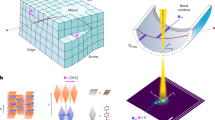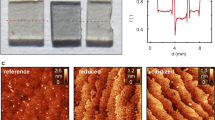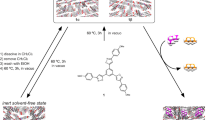Abstract
To date, the most widely used method of studying line defects in organic solids has been the dislocation-etch-pit technique (see ref. 1 and papers quoted therein). Although this approach has yielded valuable information permitting the identification of lattice imperfections which emerge at habit faces or cleavage planes, it is often necessary, in order to characterize the dislocations more fully, to assume from projection drawings of the crystal structure the planes in which translation gliding is likely to be most feasible. More information about the slip planes arid Burgers vectors may, in principle, be obtained from other techniques which have been extensively applied to metallic and other inorganic solids2–4; but organic solids present peculiar experimental difficulties. Thus field-ion microscopy5 is unsuitable because of the fragility, high vapour pressure and other properties of molecular crystals. Transmission electron microscopy is generally inapplicable because of the marked tendency for organic solids to react under electron bombardment.
This is a preview of subscription content, access via your institution
Access options
Subscribe to this journal
Receive 51 print issues and online access
$199.00 per year
only $3.90 per issue
Buy this article
- Purchase on SpringerLink
- Instant access to full article PDF
Prices may be subject to local taxes which are calculated during checkout
Similar content being viewed by others
References
Williams, J. O., and Thomas, J. M., Trans. Faraday Soc., 63, 1720 (1967).
Amelinckx, S., The Direct Observation of Dislocations (Academic Press, 1964).
Weertman, J., and Weertman, J. A., Elementary Dislocation Theory (Macmillan, 1964).
Newkirk, J. B., and Wernick, J. H., (edit. by), Direct Observation of Impcrfections in Crystals (Wiley, 1962).
Müller, E. W., Direct Observation of Imperfections in Crystals, 77 (Wiley, 1962).
Lang, A. R., J. Appl. Phys., 29, 597 (1958).
Lang, A. R., Acta Cryst., 12, 249 (1959).
Mitchell, D., Robinson, P. M., and Smith, A. P., Physica Status Solidii, 26, K93 (1968).
Mitchell, J. W., Direct Observation of Imperfections in Crystals, 3 (Wiley, 1962).
Thomas, J. M., and Williams, J. O., Chem. Commun., 432 (1967).
Thomas, J. M., Williams, J. O., and Turton, L. M., Trans. Faraday Soc., 64, 2505 (1968).
Schmidt, G. M. J., in Reactivity of the Photocxcited Molecule, 227 (Inter-science, 1967).
Cohen, M. D., in Organic Solid Chemistry (edit. by Adler, G.), 287 (Gordon and Breach, 1969).
Thomas, J. M., in Adv. in Catalysis, 19 (in the press).
Author information
Authors and Affiliations
Rights and permissions
About this article
Cite this article
COHEN, M., RON, I., SCHMIDT, G. et al. Photochemical Decoration of Dislocations inside Crystals of Acenaphthylene. Nature 224, 167–168 (1969). https://doi.org/10.1038/224167a0
Received:
Issue date:
DOI: https://doi.org/10.1038/224167a0



